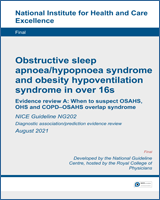From: When to suspect OSAHS, OHS and COPD–OSAHS overlap syndrome

NCBI Bookshelf. A service of the National Library of Medicine, National Institutes of Health.
| Outcomes | No of Participants (studies) Follow up | Quality of the evidence (GRADE) | Relative effect (95% CI) | Anticipated absolute effects | |
|---|---|---|---|---|---|
| Risk with Control | Risk difference with Transient ischaemic attack (95% CI) | ||||
| prevalence of OSA |
77 (1 study) |
⊕⊝⊝⊝ VERY LOW1 due to risk of bias |
RR 2.11 (1.27 to 3.49) | Moderate | |
| 328 per 1000 |
364 more per 1000 (from 89 more to 817 more)2 | ||||
Risk of bias was assessed using the QUIPS checklist. Downgraded by 1 increment if the majority of the evidence was at high risk of bias, and downgraded by 2 increments if the majority of the evidence was at very high risk of bias.
Default MID (0.5XSD) used to assess imprecision. Downgraded by 1 increment if the confidence interval crossed one MID or by 2 increments if the confidence interval crossed both MIDs. GC considered the clinical importance of the effect estimate for each analysis on a case by case basis, taking into consideration the increment of the risk factor and the outcome under study.
From: When to suspect OSAHS, OHS and COPD–OSAHS overlap syndrome

NCBI Bookshelf. A service of the National Library of Medicine, National Institutes of Health.